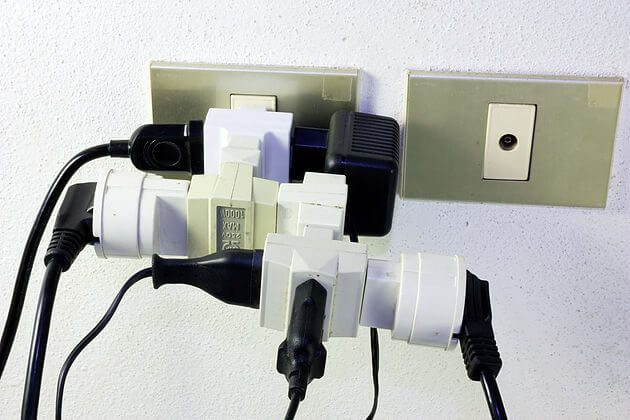Common Electrical Hazards in the Workplace
Whether you’re in the construction industry, an office environment, or anything in between, there are electrical hazards you may not be aware of. Electrical hazards are extremely dangerous as most often they are unseen during your day-to-day activities….but that doesn’t mean they aren’t there.
Throughout this blog we discuss a variety of common hazards you need to be aware of, ways to identifying electrical hazards, and discuss the precautions to take to ensure you and your team are instilling electrical safety practices so accidents do not occur.
Examples of Electrical Hazards
Overloaded Circuits and Outlets
Overloaded circuits, outlets, and electrical cords can be a simple yet dangerous circumstance in the workplace, particularly an office workplace or educational environment such as a school where a lot of electronic devices are used throughout the day. Overloading circuits and outlets can cause excessive overheating, leading to insulator damage, and the risk of an electrical fire.
To prevent overloading, you should start by understand how much energy appliances and electrical devices are using and invest in energy saver options.
Cables and Cords
Cables and cords should always be fixed out of the way to avoid trip hazards no matter the workplaces. Extension cords should never be used as a permanent substitute for power supply. If you find you need extra power points throughout the workplace to avoid over stretched cords and cables, contact a licenced, experienced electrician to install extras.
If you are using an extension cord as a temporary measure, ensure you firstly use the correct extension cord and understand the electrical load, plus have appropriate protective covers or ramps to avoid trip hazards.
Insufficient Grounding
The most important reason for grounding electrical currents is to protect your workplace and employees. Grounding electrical systems protect everyone against the risk of electrical shocks and other hazardous conditions. If any part of the electrical system does not have proper grounding, an electrical current can flow through somebody causing electrocution.
On a construction site, never remove the metallic ground pin which returns unwanted voltage to the ground. Applying electrical safety practices on construction sites is vital to protect workers from electrical accidents.
Exposed Components
Unfortunately, in the workplace things can occasionally be damaged which may cause electrical parts to be exposed and increase the risk of serious injury. This can be extremely dangerous if not fixed as electric shocks and/or burns may occur. Exposed components may include electrical mechanisms on machinery, temporary lighting and uncovered light fixtures, or detached insulation on electrical cords.
If you or your employees find exposed components in the workplace, it is not wise to attempt electrical work and repair things on your own. Call a qualified, experienced electrician to repair or replace all electrical work required.
Water Exposure
Wet conditions and electrical components do not mix well. It is vital to ensure electrical outlets and electrical wires are not being exposed to wet locations which can potentially cause an electrical shock to your employees.
Proper guarding mechanisms and safety barriers should be utilised for any nearby equipment to remove the chance of electrical incidents occurring. Damaged insulation and bad wiring are simple yet potentially flammable hazards which can be easily avoided by ensuring repairs are made by a licenced, experienced electrician.
Inadequate Wiring
Inadequate wiring is a major health and safety hazard which can be potentially lethal. Incorrect wiring can be one of the most common electrical hazards present in the workplace if proper measures have not been taken during installation.
To ensure best electrical safety practices are being met, a fully licenced, experienced electrician should be providing electrical services to guarantee the correct wire is being used to avoid potential electrical hazards occurring.
Electrical Safety in the Workplace
All workplaces use a form of electricity from the obvious office environment, through to remote building and construction sites. Electrical hazards have the ability to cause serious harm, and in some cases, life threatening circumstances. Simple measures such as providing a procedure for your employees to report damaged or faulty equipment could mean the difference between life and death.
Did you know the smoke alarms in the workplace must be regularly tested by a qualified electrician? If you’re unsure when the last inspection was at your workplace, it may be due for an update to keep everyone safe.
Unsafe Electrical Installations
To avoid unsafe electrical installations, it is vital to have a qualified, experienced electrician perform all work required. To keep your employees and workplace safe from harm, your electrician must complete all work to a high standard and comply with Occupational Health & Safety (OH&S) legislation.
Dangers of Electricity
As electricity and electrical equipment is used in all workplaces it is important to raise awareness about the proper use of electrical tools and equipment which employees may be using day-to-day.
Proper training should be provided to employees on how to identify areas within the workplace where electrical hazards may occur. If employees find an electrical hazard in the workplace it is important they understand how to correctly report it to avoid anyone receiving an unwanted electric shock or major burns.
Hazards Of Electricity And Their Safety Measures
We hope by now after reading through this blog, you understand that water and electricity do not mix well, in fact they are a deadly combination. So, what happens when an electrical fire occurs? How do you extinguish it? A Class E CO2 fire extinguisher (Carbon Dioxide CO2 fire extinguisher) is the best option to extinguish an electrical fire.
If you’re unsure whether your workplace has the correct fire extinguisher to extinguish an electrical fire, please check with your electrician or see Western Australia Department of Transport for more information.
Conclusion
It is vital to understand there are many potential electrical hazards within the workplace. You need to make sure you are performing the correct health and safety measures such as ensuring your have a regular maintenance plan in place with you electrician, and you’re applying electrical safety practices in your workplace before any potentially fatal incidents can occur.
If you do not have a regular maintenance plan in place reach out to our team at KNP Electrics to discuss your electrical maintenance options to keep your workplace safe and maintaining the standard legal requirements for Western Australia.
If you’re unsure whether your workplace is a safe environment for your team, fill in your details and receive our FREE Workplace Electrical Safety Checklist!

